| Part of a series on |
| Jewish culture |
|---|
 |
| Judaism portal |
The Hebrew word for 'symbol' is ot, which, in early Judaism, denoted not only a sign, but also a visible religious token of the relation between God and human.
| Part of a series on |
| Jewish culture |
|---|
 |
| Judaism portal |
The Hebrew word for 'symbol' is ot, which, in early Judaism, denoted not only a sign, but also a visible religious token of the relation between God and human.
| Ancient | ||
|---|---|---|
| Symbol | Image | History and usage |
| Menorah |  | Represents the Temple in Jerusalem. Appears in the Emblem of Israel. |
| Four Species |  | Represents the festival of Sukkot. Often an accompaniment of the Menorah. |
| Shofar | 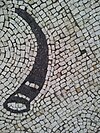 | Represents the High Holy Days. Used as an instrument harkening in the new year in a ceremonial fashion. |
| Intermediate | ||
| Symbol | Image | History and usage |
| Star of David | 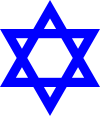 | The Star of David, a symbol of Judaism as a religion, and of the Jewish people as a whole. [1] It also thought to be the shield (or at least the emblem on it) of King David. Jewish lore links the symbol to the "Seal of Solomon", the magical signet ring used by King Solomon to control demons and spirits. Jewish lore also links the symbol to a magic shield owned by King David that protected him from enemies. Following Jewish emancipation after the French Revolution, Jewish communities chose the Star of David as their symbol. The star is found on the Flag of Israel. |
| Shin |  | Symbolizes El Shaddai (conventionally translated "God Almighty"), one of the Names of God in Judaism. This symbol is depicted on the ritual objects mezuzah and tefillin, and in the hand gesture of the Priestly Blessing. |
| Tablets of Stone | 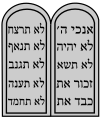 | Represents the two tablets on which the Ten Commandments were inscribed at Mount Sinai. |
| Lion of Judah | 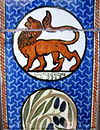 | The Tanakh compares the tribes of Judah and Dan to lions: "Judah is a lion's whelp." [2] Often a pair of lions appear as heraldic supporters, especially of the Tablets of Law. |
| Modern | ||
| Symbol | Image | History and usage |
| Chai (symbol) |  | "Life" in Hebrew. |
| Hamsa | 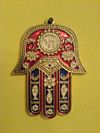 | In Jewish and other Middle Eastern cultures, the Hamsa represents the hand of God and was reputed to protect against the evil eye. In modern times, it is a common good luck charm and decoration. [3] |
| Part of a series on |
| Judaism |
|---|
   |
Shabbat, the day of rest, is described in the Tanakh as God's sign ("ot") between Him and the Jewish people. [4]
The Torah provides detailed instructions (Exodus 28) for the garments worn by the priests in the Temple. These details became the subject of later symbolic interpretations.
According to Philo: [5] The priest's upper garment symbolized the ether, the blossoms represented the earth, the pomegranates typified running water, and the bells denoted the music of the water. The ephod corresponded to heaven, and the stones on both shoulders to the two hemispheres, one above and the other below the earth. The six names on each of the stones were the six signs of the zodiac, which were denoted also by the twelve names on the breastplate. The miter was the sign of the crown, which exalted the high priest above all earthly kings.
Josephus interpreted as follows: [6] The coat symbolized of the earth, the upper garment symbolized heaven, while the bells and pomegranates represented thunder and lightning. The ephod typified the four elements, and the interwoven gold denoted the glory of God. The breastplate was in the center of the ephod, as the earth formed the center of the universe; the girdle symbolized the ocean, the stones on the shoulders the sun and moon, and the jewels in the breastplate the twelve signs of the zodiac, while the miter was a token of heaven.
The Jerusalem Talmud [7] and Midrash [8] described each garment as providing atonement for a specific sin: the coat for murder or for shatnez, the undergarment for unchastity, the miter for pride, the belt for theft or trickery, the breastplate for any perversion of the Law, the ephod for idolatry, and the robe for slander.
Various numbers play a significant role in Jewish texts or practice. Some such numbers were used as mnemonics to help remember concepts, while other numbers were considered to have intrinsic significance or allusive meaning. Numbers such as 7, 10, 12, and 40 were known for recurring in symbolic contexts.
Gematria is form of cipher used to generate a numerical equivalent for a Hebrew word, which sometimes is invested with symbolic meaning. For example, the gematria of "chai" (the Hebrew word for life) is 18, and multiples of 18 are considered good luck and are often used in gift giving.
Gold was a highly regarded precious metal (as in other cultures), but was occasionally avoided due to its association with the sin of the golden calf. [9] Silver was associated with moral purity, as silver metal must be refined from its ore. [10] Brass symbolized hardness, strength, and firmness. [11] Brass was a substitute for gold, and iron for silver. [12]
Salt was offered with every sacrifice; [13] the preservative effect of salt symbolized the eternity of the covenant between God and Israel. [14] In the Talmud salt symbolizes the Torah, for just as "the world cannot exist without salt", so it can not endure without the Torah. [15]
In the Torah, the Israelites are commanded to dye one of the threads of their tzitzit (ritual fringes) with a blue-colored dye called tekhelet . [16] This dye was highly regarded in both Jewish and non-Jewish cultures of this time, and was worn by royalty and the upper-class. In the Torah, it also appears extensively in ritual contexts such as priestly garments and the curtains of the Tabernacle. Symbolically, in Jewish thought the color of tekhelet corresponds to the color of the heavens and the divine revelation. [17] The blue color of tekhelet was later used on the tallit, which typically has blue stripes on a white garment. From the 19th century at the latest, the combination of blue and white symbolized the Jewish people, [18] and this combination was chosen for the Flag of Israel.
Argaman (Tyrian purple) was another luxurious ancient dye, and was symbolic of royal power. [19]
Tola'at shani ("scarlet") was considered a striking and lively color, [20] and was used in priestly garments and other ritual items, [21] but could also symbolize sin. [22]
White (as in linen or wool garments) symbolized moral purity. [23]
Yellow has an association with an anti-Semitic forced identification mark (see Yellow badge).

The Torah delineates three pilgrimage festivals: Passover, Shavuot, and Sukkot. Each of these is tied to the agricultural cycle of the Israelites, and also has a theological symbolism.
Passover celebrated the rebirth of nature, and symbolized the origin of the Jewish people. The eating of bitter herbs symbolized the miseries of the Egyptian bondage. In the evenings four cups of wine were drunk, to symbolize the four world-kingdoms. [24] People eating during the Passover meal reclined, in the style of free rich aristocrats, to represent their liberation from slavery.
Jeremiah beheld an almond-tree as a token of the speedy fulfillment of the word of God. [25] Amos saw a basket of summer fruit as a symbol of the approaching end of Israel. [26]
Ahijah the Shilonite tore Jeroboam's mantle into twelve pieces, to typify the division of the kingdom of Israel, [27] and Zedekiah made horns of iron to encourage Ahab to engage in war with Ramoth-gilead. [28] King Joash, at the command of the prophet Elisha, shot arrows from the open window into the air, to symbolize the destruction of his enemies. [29]
Isaiah walked naked and barefoot to show how the Egyptians and Ethiopians would be treated when taken captive by the Assyrians, [30] while Jeremiah wore a yoke upon his neck to induce the nations to submit to the King of Assyria. [31] Ezekiel was commanded to inscribe the names of certain tribes upon separate pieces of wood, to show that God would reunite those tribes. [32]

Some common themes appear on many Jewish tombstones. Two hands with outspread fingers indicated that the dead man was descended from priestly stock ( Kohanim ) who blessed the people in this fashion, and a jug was carved on the tombstones of the Levites as an emblem of those who washed the priest's hands before he pronounced the blessing.
Some gravestones show a tree with branches either outspread or broken off, symbolizing the death of a young man or an old man respectively; or they have a cluster of grapes as an emblem of Israel.
The Star of David (Magen David) occurs frequently.
Sometimes figures symbolized the name of the deceased, as the figure of a lion for Loeb, a wolf for Benjamin, and a rose for the name Bluma/Blume.
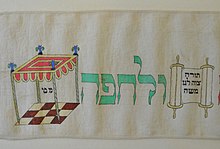
Jewish symbols are prevalent on wimpels; Torah binders made from the cloth used to swaddle a child on his Brit Milah. Common themes and symbols are linked to positive wishes for the life of the child.
On Ashkenazi Torah binders, the inscriptions often follow the same pattern. After naming the son then the father and other relevant data, a standardised saying follows; the boy should grow to the chuppa (marriage canopy) and good deeds under the guidance of the Torah.
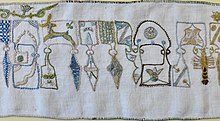
These sentences are usually illustrated with paintings or embroidery. Common symbols include plants or flowers, symbolising the tree of life (often equated with the Torah), a chuppa (to illustrate the wish for a marriage under the guidance of the Torah), a Torah scroll and crown, and animals. [33] These can reflect the zodiac constellation under which a child was born, or be a reference to their name and heritage. Deer might give an indication of the name Zvi (Hebrew), Hirsch (German) or Herschl (Yiddish), whereas a lion might symbolise the name Löw/Ariel. Lions are also associated with the Tribes of Israel, Judah and Dan. [34]
Zion is a Biblical term that refers to Jerusalem (and to some extent the whole Land of Israel), and is the source for the modern term Zionism. Mount Zion is a hill outside the walls of the Old City of Jerusalem, but the term previously referred to the Temple Mount, as well as a hill in the City of David.
Historically Jews who carried arms often use the iconography of the Lion of Judah, the Star of David, and if they were Kohens, the symbol of two hands performing the priestly benediction. However in recent years Jews granted armorial bearings often implement Zionist symbolism.
{{cite book}}: CS1 maint: location missing publisher (link)Kohen is the Hebrew word for "priest", used in reference to the Aaronic priesthood, also called Aaronites or Aaronides. They are traditionally believed and halakhically required to be of direct patrilineal descent from the biblical Aaron, brother of Moses, and thus belong to the Tribe of Levi.

An ephod was a type of apron that, according to the Hebrew Bible, was worn by the High Priest of Israel, an artifact and an object to be revered in ancient Israelite culture, and was closely connected with oracular practices and priestly ritual.
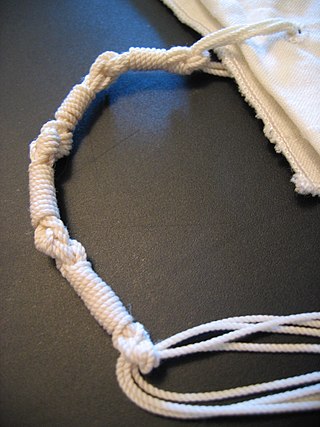
Tzitzit are specially knotted ritual fringes, or tassels, worn in antiquity by Israelites and today by observant Jews and Samaritans. Tzitzit are usually attached to the four corners of the tallit gadol, usually referred to simply as a tallit or tallis; and tallit katan. Through synecdoche, a tallit katan may be referred to as tzitzit.
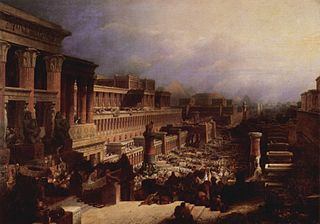
Bo is the fifteenth weekly Torah portion in the annual Jewish cycle of Torah reading and the third in the book of Exodus. The parashah constitutes Exodus 10:1–13:16. The parashah tells of the last three plagues on Egypt and the first Passover.
Tetzaveh, Tetsaveh, T'tzaveh, or T'tzavveh is the 20th weekly Torah portion in the annual Jewish cycle of Torah reading and the eighth in the Book of Exodus. The parashah reports God's commands to bring olive oil for the lamp, make sacred garments for the priests, conduct an ordination ceremony, and make an incense altar.

Ki Tisa, Ki Tissa, Ki Thissa, or Ki Sisa is the 21st weekly Torah portion (parashah) in the annual Jewish cycle of Torah reading and the ninth in the Book of Exodus. The parashah tells of building the Tabernacle, the incident of the Golden calf, the request of Moses for God to reveal God's Attributes, and how Moses became radiant.

Pekudei, Pekude, Pekudey, P'kude, or P'qude is the 23rd weekly Torah portion in the annual Jewish cycle of Torah reading. It is the 11th and last in the Book of Exodus. The parashah tells of the setting up of the Tabernacle.

Tzav, Tsav, Zav, Sav, or Ṣaw is the 25th weekly Torah portion in the annual Jewish cycle of Torah reading and the second in the Book of Leviticus. The parashah teaches how the priests performed the sacrifices and describes the ordination of Aaron and his sons. The parashah constitutes Leviticus 6:1–8:36. The parashah is made up of 5,096 Hebrew letters, 1,353 Hebrew words, 97 verses, and 170 lines in a Torah scroll. Jews read it the 24th or 25th Sabbath after Simchat Torah, generally in the second half of March or the first half of April.

Shemini, Sh'mini, or Shmini is the 26th weekly Torah portion in the annual Jewish cycle of Torah reading and the third in the Book of Leviticus. Parashah Shemini tells of the consecration of the Tabernacle, the deaths of Nadab and Abihu, and the dietary laws of kashrut. The parashah constitutes Leviticus 9:1–11:47. It is made up of 4,670 Hebrew letters, 1,238 Hebrew words, 91 verses, and 157 lines in a Torah Scroll.
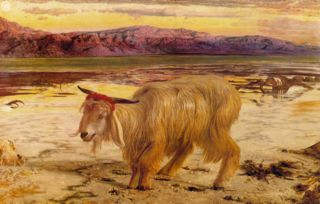
Acharei Mot is the 29th weekly Torah portion in the annual Jewish cycle of Torah reading. It is the sixth weekly portion in the Book of Leviticus, containing Leviticus 16:1–18:30. It is named after the fifth and sixth Hebrew words of the parashah, its first distinctive words.

Emor is the 31st weekly Torah portion in the annual Jewish cycle of Torah reading and the eighth in the Book of Leviticus. The parashah describes purity rules for priests, recounts the holy days, describes the preparations for the lights and bread in the sanctuary, and tells the story of a blasphemer and his punishment. The parashah constitutes Leviticus 21:1–24:23. It has the most verses of any of the weekly Torah portions in the Book of Leviticus, and is made up of 6,106 Hebrew letters, 1,614 Hebrew words, 124 verses and 215 lines in a Torah Scroll.
Bechukotai, Bechukosai, or Bəḥuqothai (Biblical) is the 33rd weekly Torah portion in the annual Jewish cycle of Torah reading and the 10th and last in the Book of Leviticus. It constitutes Leviticus 26:3–27:34. The parashah addresses blessings for obeying the law, curses for disobeying it, and vows. The parashah is made up of 3,992 Hebrew letters, 1,013 Hebrew words, 78 verses, and 131 lines in a Torah Scroll.

Bemidbar, BeMidbar, B'midbar, Bamidbar, or Bamidbor, is the 34th weekly Torah portion in the annual Jewish cycle of Torah reading and the first in the Book of Numbers. The parashah tells of the census and the priests' duties. It constitutes Numbers 1:1–4:20. The parashah is made up of 7,393 Hebrew letters, 1,823 Hebrew words, 159 verses, and 263 lines in a Torah Scroll. Jews generally read it in May or early June.

Behaalotecha, Behaalotcha, Beha'alotecha, Beha'alotcha, Beha'alothekha, or Behaaloscha is the 36th weekly Torah portion in the annual Jewish cycle of Torah reading and the third in the Book of Numbers. The parashah tells of the Menorah in the Tabernacle, the consecration of the Levites, the Second Passover, how pillars of cloud and fire led the Israelites, the silver trumpets, how the Israelites set out on their journeys, the complaints of the Israelites, and how Miriam and Aaron questioned Moses. The parashah comprises Numbers 8:1–12:16. It is made up of 7,055 Hebrew letters, 1,840 Hebrew words, 136 verses, and 240 lines in a Torah Scroll.
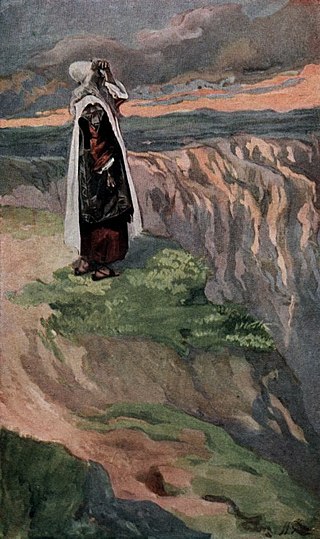
Pinechas, Pinchas, Pinhas, or Pin'has is the 41st weekly Torah portion in the annual Jewish cycle of Torah reading and the eighth in the Book of Numbers. It tells of Phinehas's killing of a couple, ending a plague, and of the daughters of Zelophehad's successful plea for land rights. It constitutes Numbers 25:10–30:1. The parashah is made up of 7,853 Hebrew letters, 1,887 Hebrew words, 168 verses, and 280 lines in a Torah scroll.
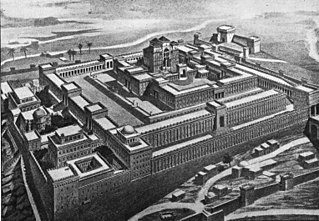
Re'eh, Reeh, R'eih, or Ree is the 47th weekly Torah portion in the annual Jewish cycle of Torah reading and the fourth in the Book of Deuteronomy. It comprises Deuteronomy 11:26–16:17. In the parashah, Moses set before the Israelites the choice between blessings and curses. Moses instructed the Israelites in laws that they were to observe, including the law of a single centralized place of worship. Moses warned against following other gods and their prophets and set forth the laws of kashrut, tithes, the Sabbatical year, the Hebrew slave, firstborn animals, and the Three Pilgrim Festivals.
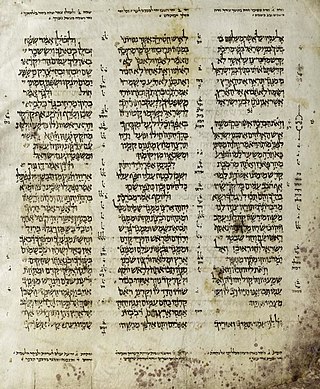
V'Zot HaBerachah, VeZos HaBerachah, VeZot Haberakha, V'Zeis Habrocho, V'Zaus Haberocho, V'Zois Haberuchu, Wazoth Habborocho, or Zos Habrocho is the 54th and final weekly Torah portion in the annual Jewish cycle of Torah reading and the 11th and last in the Book of Deuteronomy. It constitutes Deuteronomy 33:1–34:12. The parashah sets out the farewell Blessing of Moses for the 12 Tribes of Israel and concludes with the death of Moses.

The priestly undergarments were "linen breeches" (KJV) worn by the priests and the High Priest in ancient Israel. They reached from the waist to the knees and so were not visible, being entirely hidden by the priestly tunic.
Various numbers play a significant role in Jewish texts or practice. Some such numbers were used as mnemonics to help remember concepts, while other numbers were considered to have intrinsic significance or allusive meaning.
According to Judaism, the priestly covenant is the biblical covenant that God gave to Aaron and his descendants, the kohanim. This covenant consisted of their exclusive right to serve in the Temple, and to consume sacrificial offerings and receive other priestly gifts.
![]() This article incorporates text from a publication now in the public domain : Singer, Isidore; et al., eds. (1901–1906). "Symbol". The Jewish Encyclopedia . New York: Funk & Wagnalls.
This article incorporates text from a publication now in the public domain : Singer, Isidore; et al., eds. (1901–1906). "Symbol". The Jewish Encyclopedia . New York: Funk & Wagnalls.